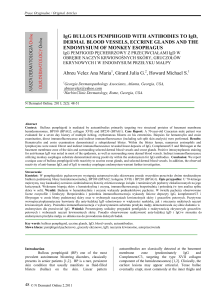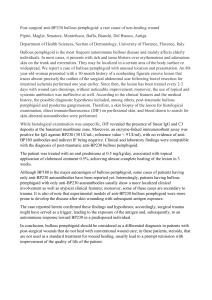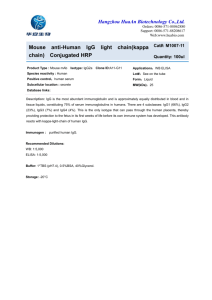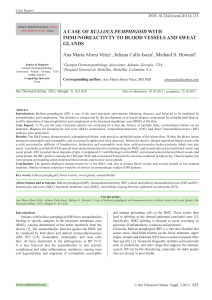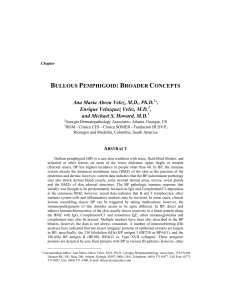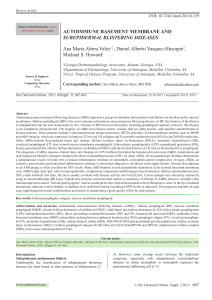IgGIgDBPendomysiumvessels nerves sweats
advertisement
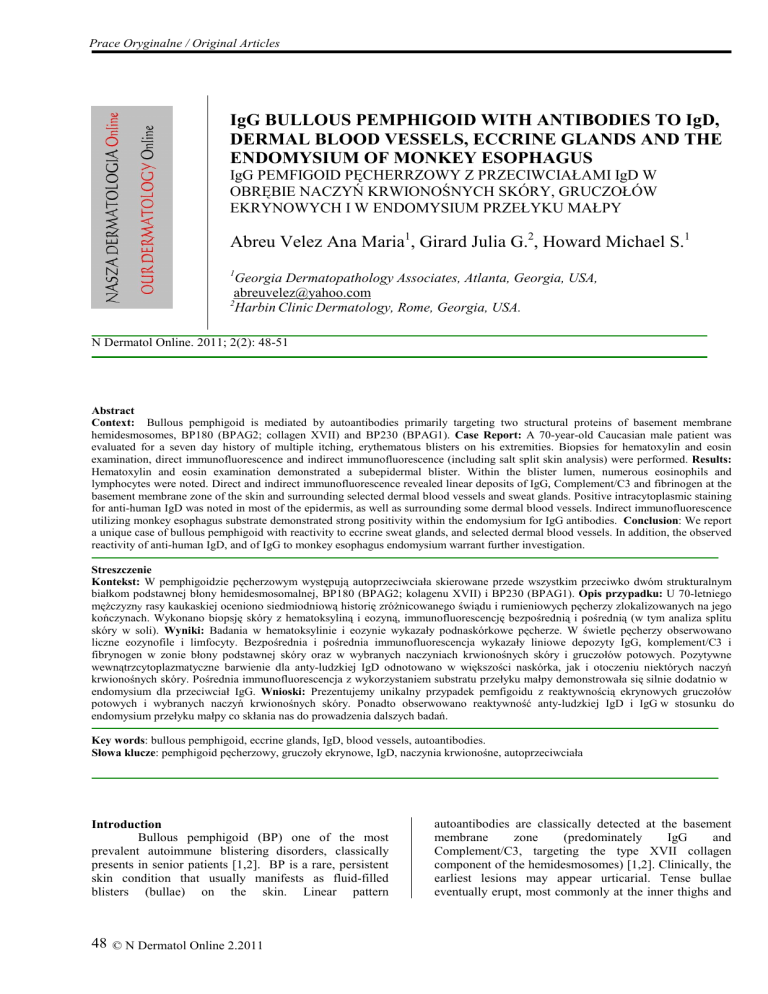
Prace Oryginalne / Original Articles IgG BULLOUS PEMPHIGOID WITH ANTIBODIES TO IgD, DERMAL BLOOD VESSELS, ECCRINE GLANDS AND THE ENDOMYSIUM OF MONKEY ESOPHAGUS IgG PEMFIGOID PĘCHERRZOWY Z PRZECIWCIAŁAMI IgD W OBRĘBIE NACZYŃ KRWIONOŚNYCH SKÓRY, GRUCZOŁÓW EKRYNOWYCH I W ENDOMYSIUM PRZEŁYKU MAŁPY Abreu Velez Ana Maria1, Girard Julia G.2, Howard Michael S.1 1 Georgia Dermatopathology Associates, Atlanta, Georgia, USA, abreuvelez@yahoo.com 2 Harbin Clinic Dermatology, Rome, Georgia, USA. N Dermatol Online. 2011; 2(2): 48-51 Abstract Context: Bullous pemphigoid is mediated by autoantibodies primarily targeting two structural proteins of basement membrane hemidesmosomes, BP180 (BPAG2; collagen XVII) and BP230 (BPAG1). Case Report: A 70-year-old Caucasian male patient was evaluated for a seven day history of multiple itching, erythematous blisters on his extremities. Biopsies for hematoxylin and eosin examination, direct immunofluorescence and indirect immunofluorescence (including salt split skin analysis) were performed. Results: Hematoxylin and eosin examination demonstrated a subepidermal blister. Within the blister lumen, numerous eosinophils and lymphocytes were noted. Direct and indirect immunofluorescence revealed linear deposits of IgG, Complement/C3 and fibrinogen at the basement membrane zone of the skin and surrounding selected dermal blood vessels and sweat glands. Positive intracytoplasmic staining for anti-human IgD was noted in most of the epidermis, as well as surrounding some dermal blood vessels. Indirect immunofluorescence utilizing monkey esophagus substrate demonstrated strong positivity within the endomysium for IgG antibodies. Conclusion: We report a unique case of bullous pemphigoid with reactivity to eccrine sweat glands, and selected dermal blood vessels. In addition, the observed reactivity of anti-human IgD, and of IgG to monkey esophagus endomysium warrant further investigation. Streszczenie Kontekst: W pemphigoidzie pęcherzowym występują autoprzeciwciała skierowane przede wszystkim przeciwko dwóm strukturalnym białkom podstawnej błony hemidesmosomalnej, BP180 (BPAG2; kolagenu XVII) i BP230 (BPAG1). Opis przypadku: U 70-letniego męŜczyzny rasy kaukaskiej oceniono siedmiodniową historię zróŜnicowanego świądu i rumieniowych pęcherzy zlokalizowanych na jego kończynach. Wykonano biopsję skóry z hematoksyliną i eozyną, immunofluorescencję bezpośrednią i pośrednią (w tym analiza splitu skóry w soli). Wyniki: Badania w hematoksylinie i eozynie wykazały podnaskórkowe pęcherze. W świetle pęcherzy obserwowano liczne eozynofile i limfocyty. Bezpośrednia i pośrednia immunofluorescencja wykazały liniowe depozyty IgG, komplement/C3 i fibrynogen w zonie błony podstawnej skóry oraz w wybranych naczyniach krwionośnych skóry i gruczołów potowych. Pozytywne wewnątrzcytoplazmatyczne barwienie dla anty-ludzkiej IgD odnotowano w większości naskórka, jak i otoczeniu niektórych naczyń krwionośnych skóry. Pośrednia immunofluorescencja z wykorzystaniem substratu przełyku małpy demonstrowała się silnie dodatnio w endomysium dla przeciwciał IgG. Wnioski: Prezentujemy unikalny przypadek pemfigoidu z reaktywnością ekrynowych gruczołów potowych i wybranych naczyń krwionośnych skóry. Ponadto obserwowano reaktywność anty-ludzkiej IgD i IgG w stosunku do endomysium przełyku małpy co skłania nas do prowadzenia dalszych badań. Key words: bullous pemphigoid, eccrine glands, IgD, blood vessels, autoantibodies. Słowa klucze: pemphigoid pęcherzowy, gruczoły ekrynowe, IgD, naczynia krwionośne, autoprzeciwciała Introduction Bullous pemphigoid (BP) one of the most prevalent autoimmune blistering disorders, classically presents in senior patients [1,2]. BP is a rare, persistent skin condition that usually manifests as fluid-filled blisters (bullae) on the skin. Linear pattern 48 © N Dermatol Online 2.2011 autoantibodies are classically detected at the basement membrane zone (predominately IgG and Complement/C3, targeting the type XVII collagen component of the hemidesmosomes) [1,2]. Clinically, the earliest lesions may appear urticarial. Tense bullae eventually erupt, most commonly at the inner thighs and upper arms; however, the trunk and extremities are frequently involved [1,2]. The diagnosis must be confirmed by routine histologic analysis and direct immunofluorescence (DIF) of lesional and perilesional skin, respectively [1-3]. Indirect immunofluorescence (IIF), with the use of a sodium chloride–split normal human skin substrate, further distinguishes BP from epidermolysis bullosa acquisita (EBA), which may otherwise be indistinguishable clinically, histologically, and via immunofluorescence [1-3]. Recently, multiple enzyme-linked immunosorbent assay (ELISA) tests of high sensitivity and specificity have been developed and utilized for the confirmation of BP autoantibodies. Case Report A 70 -year-old Caucasian male patient was evaluated for a 7 day history of several itching, erythematous blisters on his extremities. Biopsies for hematoxylin and eosin (H & E) examination, direct immunofluorescence and indirect immunofluorescence (including salt split skin analysis on monkey esophagus substrate) were performed as previously described in detail [3-7]. The patient reported no clinical symptoms of celiac disease. The patient serum also tested positive for bullous pemphigoid (BP) utilizing a commercial enzyme linked immunosorbent assay (ELISA) Mesacup test (MBL International, Woburn, Massachusetts, USA). Results In Figure 1, we highlight our most significant H&E, DIF and IIF results, including deposition analysis of basement membrane zone (BMZ) autoantibodies utilizing a 0.1M sodium chloride IIF split skin technique on normal human skin substrate. In addition, IIF findings are described utilizing monkey esophagus substrate studies. In brief, microscopic examination of the H&E tissue sections demonstrated a subepidermal blistering disorder. Within the blister lumen, numerous eosinophils are present, with occasional lymphocytes and neutrophils also seen. Within the dermis, a mild, superficial, perivascular infiltrate of lymphocytes, histiocytes and eosinophils was identified. DIF studies were performed, and displayed the following results: IgG (+++, Linear BMZ; and surrounding dermal eccrine sweat glands and selected deep dermal blood vessels); IgG3(-); IgG4(-); IgA(-): IgM(-); IgD (++, intra-cytoplasmic in epidermal keratinocytes, and surrounding selected dermal blood vessels); IgE (-); Complement/C1q(-); Complement/C3(++, linear shaggy BMZ and also within eccrine glands); albumin (++, linear BMZ and within eccrine glands) and fibrinogen (++, deep dermal perivascular). Indirect immunofluorescence (IIF) studies were performed on normal human skin substrate, and displayed the following results: IgG(++, linear BMZ, within eccrine glands, and surrounding deep dermal blood vessels); IgA(-); IgM(-); IgD(++, intracytoplasmic on epidermal keratinocytes, and also surrounding superficial dermal blood vessels); IgE (-); albumin (++, linear BMZ), Complement/C1q(-); Complement/C3(+++, linear BMZ); fibrinogen (++, deep dermal perivascular) and with salt split skin (++, IgG and C3 accentuated on the blister roof). Utilizing monkey esophagus and patient serum, we detected strong reactivities at the BMZ, and also within the endomysium (fig.1). Discussion: Bullous pemphigoid (BP) is an autoimmune blistering disease. The most common disease associated autoantibodies are directed against two protein components of the BMZ hemidesmosomes; specifically, BP180 and BP230 [1-3]. One group of authors has investigated whether BP patients also have autoantibodies targeting plectin, another hemidesmosome protein component with extensive homology to BP230 [8]. They tested sera from 16 patients with BP, utilizing immunoprecipitation (IP) studies followed by immunoblotting (IB). Serum of one of the 16 patients with BP (6%) contained autoantibodies binding to plectin, while no reactivity was found with sera from three control subjects. Sera from all 16 BP patients immunoprecipitated BP230 from extracts of biosynthetically radiolabelled human keratinocytes [8].The authors concluded that sera from BP patients might contain autoantibodies binding to plectin. Notably, bullous pemphigoid antigen 1, plectin, desmoplakin, envoplakin, and periplakin are all members of the plakin protein family of cytolinkers. These proteins are present within eccrine glands and the dermal/epidermal BMZ [9]. The BMZs of the skin and its appendices are very complex biochemical structures, including other molecules such as alpha integrin 2, which has been described in developing eccrine glands [10]. In addition, it has been shown that human eccrine glands recapitulate human epidermal structures and constituents. Proteins such as filaggrin, loricrin, involucrin, envoplakin, periplakin, and transglutaminases I and III match the constitutional pattern of normal human skin, and the structural qualities of junctional complexes and hemidesmosomes are preserved. [11]. Both the eccrine gland and dermal/epidermal BMZs classically contain collagen IV CIV) [12]. Fibronectin and laminin are also conserved molecules within epidermal and eccrine gland hemidesmosomes [13-15]. Further, monkey esophagus endomysium contains CIV. Thus, we suggest that BP patients may develop autoantibodies to any of these proteins, expressed in multiple anatomic structures. Further studies are necessary to further confirm this possibility, and to determine potential new directions in clinical treatment. Acknowledgement Our study was supported by funding from Georgia Dermatopathology Associates, Atlanta, Georgia, USA. © N Dermatol Online 2.2011 49 Figure 1. a, FITCI conjugated Complement/C3 positive in a linear, shaggy pattern at the BMZ; and in b, within dermal eccrine glands (green staining, white arrows). c and d. FITCI conjugated IgG positivity. In c, on monkey esophagus substrate, demonstrating strong positivity to anti-endomysial antibodies; in d, at the periphery of dermal eccrine glands (green staining, red arrows). Nuclei are counterstained with Dapi(light blue). e. FITCI conjugated IgD positive intracytoplasmic staining, surrounding epidermal keratinocyte nuclei, and also noted surrounding dermal blood vessels (green staining, white arrows). f. One molar sodium chloride (NaCl) salt split skin IIF demonstrates deposits of FITCI conjugated IgG on blister roof and floor, accentuated on the roof (green staining, white arrows). g. Shows deposits of FITCI conjugated IgG around deep dermal blood vessels (green staining, white arrows). Selected cell nuclei are again counterstained with Dapi. h. Again utilizing monkey esophagus, note the strong reactivity to dermal blood vessels using FITC conjugated anti-human IgG (green-yellow staining, red arrow). i. H&E of a subepidermal blister, displaying a brisk infiltrate of eosinophils and some neutrophils (red arrow). 50 © N Dermatol Online 2.2011 REFERENCES / PIŚMIENNICTWO: 1. Bénéton-Benhard N: Bullous pemphigoid. Presse Med. 2010; 39: 1058-1065. 2. Hertl M, Niedermeier A, Borradori L.: Autoimmune bullous skin disorders. Ther Umsch. 2010; 67: 465-482. 3. Abreu-Velez AM, Smith JG, Howard MS: IgG/IgE bullous pemphigoid with CD45 lymphocytic reactivity to dermal blood vessels, nerves and eccrine sweat glands. North Am J Med Sci 2010; 2: 538-541. 4. Abreu Velez AM, Klein AD, Howard MS: Autoreactivity to sweat glands and nerves in clinical scabies infection. North Am J Med Sci 2010; 2: 422-425. 5. Abreu Velez AM, Jackson BL, Howard MS: Deposition of immunoreactants in a cutaneous allergic drug reaction. North Am J Med Sci. 2009; 1: 180-183. 6. Abreu Velez AM, Howard MS, Hashimoto K, Hashimoto T: Autoantibodies to sweat glands detected by different methods in serum and in tissue from patients affected by a new variant of endemic pemphigus foliaceus. Arch Dermatol Res. 2009; 301: 711-718. 7. Abreu Velez AM, Howard MS, Loebl AM.: Autoreactivity to sweat and sebaceous glands and skin homing T cells in lupus profundus. Clin Immunol. 2009; 132, 420-424. 8. Laffitte E, Favre B, Fontao L, Riou S, Jaunin F, et al: Plectin, an unusual target antigen in bullous pemphigoid. Br J Dermatol. 2001; 144: 136-138. 9. Fontao L, Favre B, Riou S, Geerts D, Jaunin F, et al: Interaction of the bullous pemphigoid antigen 1 (BP230) and desmoplakin with intermediate filaments is mediated by distinct sequences within their COOH terminus. Mol Biol Cell. 2003; 14: 1978–1992. 10. Hertle MD, Adams JC, Watt FM.: Integrin expression during human epidermal development in vivo and in vitro. Development. 1991; 112: 193-206. 11. Biedermann T, Pontiggia L, Böttcher-Haberzeth S, Tharakan S, Braziulis E, et al: Human eccrine sweat gland cells can reconstitute a stratified epidermis. J Invest Dermatol. 2010; 130: 1996-2009. 12. Hasegawa H, Naito I, Nakano K, Momota R, Nishida K, et al: Arch Histol. The distributions of type IV collagen alpha chains in basement membranes of human epidermis and skin appendages. Cytol. 2007; 70: 255-265. 13. Hertle MD, Adams JC, Watt FM: Integrin expression during human epidermal development in vivo and in vitro. Development. 1991; 112: 193-206. 14. Mori M, Shrestha P, Takagi H, Ogata K, Takai Y: Immunohistochemical evaluation of tenascin in benign eccrine gland tumors: comparison with laminin and fibronectin. J Dermatol Sci. 1995; 9:123-128. 15. Fyrand O: Studies on fibronectin in the skin. I. Indirect immunofluorescence studies in normal human skin. Br J Dermatol. 1979; 101: 263-270. © N Dermatol Online 2.2011 51
